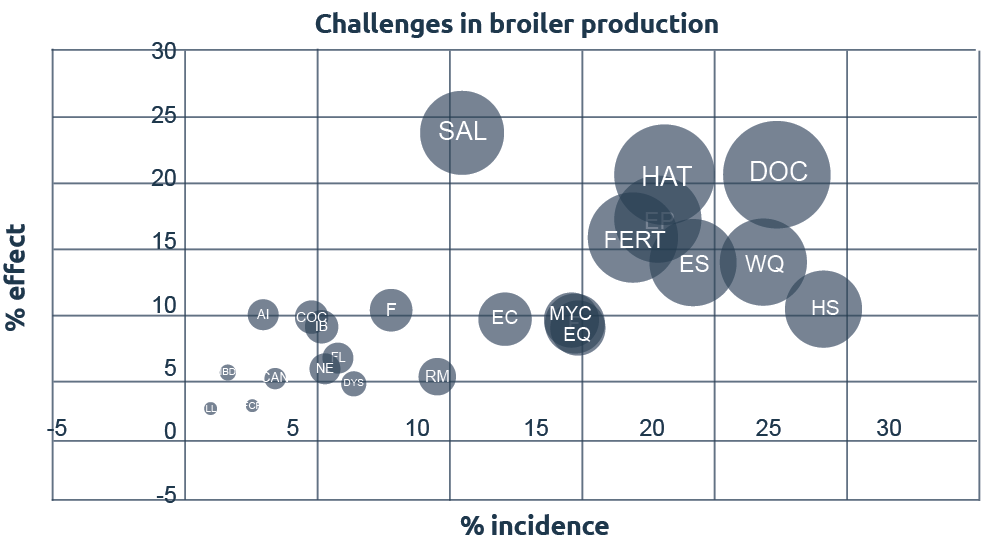For several decades, the poultry industry has regularly faced international, national as well as local challenges. These challenges can remain manageable or become a crisis or an opportunity. It al depends on how fast these challenges are recognized and how we respond to them.
In general, one could classify the challenges into 4 main categories.
- Consumer and market behavior. For example, the fipronil crisis in Europe certainly affected egg consumption temporally on a global scale because of the international trade.
- Legislation. Certainly in Europe, a big challenge in the poultry industry is to become more sustainable and contribute to a better climate, environment and wellbeing of the animals while remaining profitable.
- Poultry. As genetic companies continuously try to improve animal performance, quality, and robustness within consumer acceptance levels, metabolism and responses to environment may change.
- General poultry husbandry and daily activities. An example of this could be that due to extreme weather conditions, electricity on farms could not be guaranteed, so that climate control as well as feeding and drinking management becomes a real challenge.
In late 2020, in full Covid-19 crisis, Agrimprove’s global sales and technical service team, questioned the industry about which challenges they were/are facing in the broiler production chain, their broiler breeder operations and for their commercial layer farms. The outcome of this survey is very interesting as differences in challenges between poultry types (broilers versus layers versus breeders) become more visible, as well as differences in regions.
In this article, we will focus on the outcome for commercial layers (figure 1) and broiler breeders (figure 2) and indicate some potential strategies to manage the challenges better. Not all challenges indicated by the industry (+/-25) are mentioned in the figures. We limit ourselves here to the 10 most important per poultry type. The objective of this inquiry was not to find the cause or reason why these are the (main) challenges faced by the industry but to establish a priority regarding the incidence and negative effect on performance.

It is quite obvious that in commercial layers heat stress is a big challenge and will require full attention of the layer managers. With the global warming this will not diminish in the future. In addition, water quality also a point of concern and which is a bit easier and generally less costly to solve. Challenges related to egg production (mainly persistency) , egg quality and egg size are next in line as challenges. These latter challenges and the water quality issues can be controlled by using Medium Chain Fatty Acids (MCFAs). Shellbiotic, a product mainly based on MCFAs, has strong antibacterial activities and immune modulating properties and as such can contribute to the challenges mentioned above. Shellbiotic improves persistency of lay, directly improves the albumen quality as measured by Haugh Units (HU) and indirectly improves shell quality (less 2nd grade eggs). Flocks using Shellbiotic are less subject to stress as is indicated by the heterophyl/ lymphocyte ratio (H/L). Because of these properties related to the free active MCFAs the animal improves the protein efficiency (egg mass as well as albumen quality). Next to the performance related challenges, foodsafety issues such as E. Coli and Salmonella are also important, and for that MCFAs are known to have a significant effect on that.

Similar outcome was noticed for broiler breeders (figure 2) in terms of performance parameters and food¬safety issues with Salmonella having more impact. Probably due to the “stamping out” procedure that cus¬tomers use when a breeder flock is found positive for Salmonella. Additionally, hatchability and day-old chick quality are in the top 5 challenges. Both parameters can be positively influenced by improving the quality of the albumen. The albumen is not only a nutritional source for the developing embryo, but also has a strong antibacterial activity that prevents embryonic mortality.
A trial in India (figure 3) indicated that when adding Shellbiotic to the feed from 44 to 68 weeks of age, 3.1 more day-old chicks were achieved by improving laying performance as well as hatchability.


As was indicated by the survey made by the Agrimprove team, day-old chick quality, hatchability, laying persistency an egg quality are major challenges for the poultry industry and Shellbiotic can contribute to manage these challenges better.